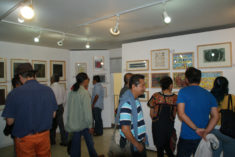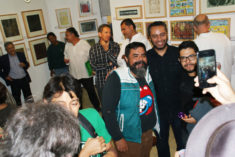Prints from the other side of the Atlantic / Impresiones del otro lado del Atlántico
Aquatint etchings, lithographs and monotypes / aguafuertes al aguatinta, Litografías y monotipos
by Eberhard Hartwig, Germany / de Eberhard Hartwig, Alemania
29. Juli bis 20. August 2017
Eröffnung/Opening/Inauguración: 29. Juli 2017, 18:00hrs
Ort/Location: GALERIA 910 OAXACA, Calle Macedonio Alcalá 305, Interior 3y 4, primer piso, Centro Historico, 68000 Oaxaca, Oax., Mexiko
Öffnungszeiten/Opening times: Mo – Sa 10 – 21, So 15 – 21 Uhr. / Horario: Lunes a Sabado de 10:00 a 21:00 hrs., Domingos de 15:00 a 21:00 hrs.
Die Ausstellung wurde mit einem kurzen Radiointerview vorab beworben und in einer Zeitungsrezension besprochen. / The exhibition was pre-advertised with a short radio interview and discussed in a newspaper review.
Eberhard Hartwig hat sich in den vergangenen Jahren nicht nur als Drucker, Werkstattleiter, Galerist und Herausgeber, sondern auch als bildender Künstler einen Namen gemacht, sowohl als Maler als auch in besonderem Maße als Graphiker. Dabei dominieren auch in seiner Malerei graphische Elemente.
In den Mischtechniken auf Leinwand und öfter noch auf Papier, den Collagen mit Übermalungen, den Farblithographien, den Radierungen, Farbradierungen und Monotypien zeigt sich auf den ersten Blick eine scheinbare Unordnung. Farbflächen, die nebeneinanderliegen, sich teilweise durchdringen, welche, die sich bedrohlich, meist von oben, ins Bild schieben, wieder andere farblich hell, zerfasernd, sich auflösend, farblich homogene Flächen stehen neben solchen mit sichtbaren Pinselstrukturen oder wirbelnden Ätzflächen. So erreicht der Künstler eine Räumlichkeit, die, außer in den kleinformatigen Landschaftsradierungen, nicht proportional in die Tiefe geht, sondern nach oben, dem Betrachter entgegen gehoben scheint.
Aber in allen Bildern wird sie spürbar, die sich bemühende ordnende Hand, in der kreativen Zuordnung der Flächen, aber besonders in der oft darübergelegten Zeichnung, sei es nun mit dem Pinselstrich oder den radierten Linien. Diese setzen einen eigenen Akzent, oft aber sollen sie die Flächen konturieren, sie bändigen. Aber Letzteres gelingt ihnen nicht, weil das Liniengebilde scheinbar abgehoben, verrutscht zu sein scheint. In anderen Arbeiten werden gestrichelt strukturierte Flächen horizontal und vertikal gegeneinander gesetzt. Kanten werden so durch Überzeichnungen, Übermalungen oder Überklebungen geläutert.
Es ist eine abbildende Kunst mit mehr oder weniger starken Tendenzen zum Ungegenständlichen, der reale Vorlagen vorausgegangen sind oder Pate gestanden haben, wie die verrätselten, anspielungsreichen Bildtitel verraten. Es sind Bilder, in denen sich gesehene Realität mit eigener Befindlichkeit und kreativer Gestaltungskraft durchdringen, die mit ihren aufgebrochenen, zergliedernden Elementen den Charakter ursprünglicher Chiffren erhalten. Sprachmittel der lyrisch-expressiven Abstraktion finden z.T. Eingang in den Hartwigschen Formenkanon.
Dazu kommt das Prinzip der Reihung, das es in vielen seiner Bilder gibt, die sich in ihrer Abstraktion der Gegenstandslosigkeit nähern. Am deutlichsten wird das in den Graphiken, die von der Ursprungsradierung Regatta ausgehend, hin zu der Gatta- und Ogatta-Folge führen, aber auch in den Blättern von der Reede, die alle von einem Boots- oder Schiffskörper ausgehen, bis hin zur Darstellung der gerollten Heu- und Strohballen, ursprünglich gesehen und in den Motivkanon aufgenommen auf einer Reise in die französische Provence.
Diese Bilder mit ihrer atmosphärischen Stimmung zeichnen sich durch eine Dichte und Tiefe aus, die der Künstler durch wiederholte Überlagerungen, durch in sich verwobene Strukturen und die Verschränkung der Räume erreicht. Offene Formen verzaubern fest Gefügtes. …
Eine weitere Werkgruppe im Oevre des Künstlers sind die kleinformatigen Kaltnadelradierungen von Studienaufenthalten in u.a. Dänemark, Großbritannien, Schweden, Frankreich sowie vom Darß, oder aus dem Oderbruch. Diesen kleinen Radierungen merkt man förmlich die Freude an der gesehenen Wirklichkeit, an den Landschaftsformationen und Naturformen, an der gewachsenen Un-Ordnung und deren Harmonie an.
Sie sind meist ausgeführt in der Kaltnadeltechnik, jener Technik also, die scheinbar ohne Eleganz und Esprit, dafür spröde und kantig ist. Aber sie ist damit vielleicht die direkteste und ehrlichste in ihrer Sprache. Sie fordert den kräftigen, zupackenden Griff des Künstlers. Linien und Linienstücke formen die Bildmotive. Schraffuren schaffen Flächen, die manchmal wie selbstständig wirkende Partien neben den Formen und Figuren stehen, ästhetische Pendants sind. Es ist eine kantige Figuren- und Formenzeichnung. Diese kleinen Blätter sind sowohl eigenständige Kunstwerke wie auch graphische Skizzen für die im Atelier entstehenden größeren Ätzradierungen, Lithographien und Monotypien.
Dabei ist der Künstler vor der Landschaft ein sensibler bis meditativer Landschaftsdarsteller. In der Stadt aber wird er zum Chronisten, Porträtisten und Bewahrer. Hier sind es meist Einzelmotive, die darstellungswürdig werden: die Straßenlaterne etwa oder der K(anonen)ofen.
Nimmt zwar die Kaltnadelradierung einen wichtigen Platz ein, doch gibt es daneben auch die anderen bildkünstlerischen Techniken der Druckgraphik, nicht selten in experimenteller Kombination. Das Vorhandensein einer Druckwerkstatt scheint oft oder immer zu experimentellem Umgang mit graphischen Techniken anzuregen.
Und immer wieder stößt man im Werk des Künstlers auf diese Besonderheit: Die „Betitelung“. Die Titel sind selbst gefundene Wortspielereien aus dem Motiv oder der topografischen Bezeichnung heraus, oft aus zwei Wörtern bestehend, aber zu einem Wort zusammengefügt. Sie bewegen sich also zwischen tatsächlicher Beschreibung und scheinbarem Nonsens, die sich dem uninformierten Betrachter nur stückweise oder gar nicht erschließen. Hier ist er ein Provokateur. Wie ist es denn: Meist schauen wir doch bei der Betrachtung eines Bildes zuerst auf den Titel und dann auf das Bild, um es zu verstehen. Seine verballhornenden oder verrätselten Titel sollen weiteres Nachdenken provozieren.
. aus: „Impresiones del otro lado del Atlántico . Monotipos, acúatintas, aguafuertes y litografías“, Faltblatt zur Ausstellung in der Galerie 910 . Oaxaca, Mexico, mit einem Text von Volkhard Böhm, 2011, Oaxaca 2017
Eberhard Hartwig – The artist
In recent years, Eberhard Hartwig has made a name for himself as a printer, as a workshop manager, gallery owner and publisher, but also as an artist, both as a painter and as well as to a special extent as a graphic artist. At the same time, graphic elements also dominate in his painting.
In the mixing techniques on canvas and more often on paper, the collages with overpaintings, the color lithographs, the etchings, color etching and monotypes, a seeming disorder appears at first sight. Color areas that are juxtaposed, partially penetrate, which are threatening, mostly from above, in the picture push, again differently bright, fusing, dissolving, color homogeneous surfaces stand beside those with visible brush structures or swirling etching surfaces. So the artist reaches a spatiality which, except in the small-format landscape etchings, does not goes proportionally in depth, but rather to the top, elevate seems come towards to the viewer.
But in all the pictures it is palpable, the striking hand, in the creative allocation of the surfaces, but especially in the often overlaid drawing, whether with the brush stroke or the etched lines. But in all pictures she is palpable, the endeavoring ordering hand, in the creative allocation of the areas, but especially in the often overlaid drawing, whether with the brush stroke or the etched lines. These have their own accent, but they are often intended to outline the areas, to curb them. The lines does not succeed because the lines figment seem to be offshoot. But the latter them does not succeed because the lines figment to seem seemingly lifted, slipped. In other works, dashed textured areas are placed horizontally and vertically against each other. Edges are thus be clarified by overdrawing, over-painting or over-glueing.
It is a depicting art with more or less strong tendencies to the non-figurative, the real templates have preceded or have stood godfather, as the enigmatic, full of allusions picture title reveal. They are pictures, in which reality seen penetrate with own feeling and creative design force, that to receive with their broken up, dissecting elements the character of original initially chiffres. Linguistic means of lyrical-expressive abstraction find, for example, Entrance into the Hartwig’s formal canon.
In addition, the principle of series duplication, which can be found in many of his pictures, the approach in their abstraction to the non-figurativity. This is most noticeable in the graphics, which, starting from the initial etching REGATTA, lead to the GATTA- and OGATTA-Series, but also in the sheets of paper of the REEDE (roadstead), All of which emanate from a boat or ship’s body, up to the representation of the rolled hay and straw bales, originally seen and taken in the motif canon on a trip to the French Provence.
These pictures with their atmospheric mood are characterized by a density and depth, which the artist reaches through repeated overlays, through in itself interwoven structures and the entanglement of the spaces. Open forms enchant fixed builted. …
Another work group in the artist’s oeuvre are the small-format cold-needle/ Drypoint etchings by study visits to, among others Denmark, Great Britain, Sweden, France, Darss, as well as by the Darss, or from the Oderbruch. This small etchings you realize literally the joy of seen reality, of the landscape formations and natural forms, of the grown un-order and their harmony.
They are usually executed in the cold needle technique, of that technique, which apparently without elegance and esprit, however is brittle and angular. But it is thus perhaps the most directly and honestly in their language. It demands the powerful, gripping the handle of the artist. Lines and line segments forming the motifs. Hatching create surfaces, which sometimes stand as independent acting parts besides the forms and figures, are aesthetic counterparts. It is an angular figure and shape drawing. These small leaves are both independent works of art and also graphic sketches for the larger etchings with acid, lithographs and monotypes arising in the studio.
At the same time the artist are in front of the landscape is a sensitive and meditative landscape artist. In the city, however, he becomes a chronicler, portraitist and preserver. Here are mostly individual motifs that are worthy of representation: the street lanterns for example, or the cannon stove.
Although the cold-needle engraving occupies an important place, there are also the other artistic techniques of printing graphics, not infrequently in experimental combinations. The presence of his printing work studio seems to be often or always to an experimental handling of graphic techniques.
And in the work of the artist, one repeatedly is found this peculiarity: the „titling“ of the pictures. The titles are self-found word games out of the motif or the topographical name, Often consisting of two words, but combined into one word. They thus move between the actual description and the apparent nonsense, which are only accessible to the uninformed viewer in a piecemeal manner or not at all. Here he is a provocateur. How is it: Usually, when we are looking at a picture, we first look at the title and then at the picture, to understand it. His misleading or enigmatic titles are meant to provoke further contemplation.
. from: „Impresiones del otro lado del Atlántico. Monotipos, acúatintas, aguafuertes y litografías “ („Impressions from the other side of the . Atlantic. Monotypes, aquatints, etchings and lithographs“), leaflet for the exhibition in the gallery 910 Oaxaca, Mexico, with a text by . Volkhard Böhm, 2011, Oaxaca 2017
Abb. im Titel: Last Form maked, 08/2009, Mehrfarb-Lithographie, Unikat, 28,5 x 38,2 cm randlos, sign 1/1
Zum Vergrößern und für weitere Informationen klicken Sie bitte auf die Abbildungen. / To enlarge and for further information please click on the pictures.













